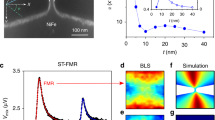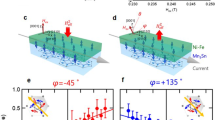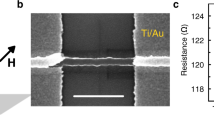Abstract
Spin–orbit torques (SOTs) in multilayers of ferromagnetic (FM) and non-magnetic (NM) metals can manipulate the magnetization of the FM layer efficiently. This is employed, for example, in non-volatile magnetic memories for energy-efficient mobile electronics1,2 and spin torque nano-oscillators3,4,5,6,7 for neuromorphic computing8. Recently, spin torque nano-oscillators also found use in microwave-assisted magnetic recording, which enables ultrahigh-capacity hard disk drives9. Most SOT devices employ spin Hall10,11 and Rashba12 effects, which originate from spin–orbit coupling within the NM layer and at the FM/NM interfaces, respectively. Recently, SOTs generated by the anomalous Hall effect in FM/NM/FM multilayers were predicted13 and experimentally realized14. The control of SOTs through crystal symmetry was demonstrated as well15. Understanding all the types of SOTs that can arise in magnetic multilayers is needed for a formulation of a comprehensive SOT theory and for engineering practical SOT devices. Here we show that a spin-polarized electric current known to give rise to anisotropic magnetoresistance (AMR) and the planar Hall effect (PHE) in a FM16 can additionally generate large antidamping SOTs with an unusual angular symmetry in NM1/FM/NM2 multilayers. This effect can be described by a recently proposed magnonic mechanism17. Our measurements reveal that this torque can be large in multilayers in which both spin Hall and Rashba torques are negligible. Furthermore, we demonstrate the operation of a spin torque nano-oscillator driven by this SOT. These findings significantly expand the class of materials that exhibit giant SOTs.
This is a preview of subscription content, access via your institution
Access options
Access Nature and 54 other Nature Portfolio journals
Get Nature+, our best-value online-access subscription
$29.99 / 30 days
cancel any time
Subscribe to this journal
Receive 12 print issues and online access
$259.00 per year
only $21.58 per issue
Buy this article
- Purchase on Springer Link
- Instant access to full article PDF
Prices may be subject to local taxes which are calculated during checkout



Similar content being viewed by others
Data availability
All data supporting the findings of this study are available within the article and the Supplementary Information and are available at the University of California Data Repository at https://doi.org/10.15146/R3H09M. All the data are available from the authors on request.
References
Miron, I. M. et al. Perpendicular switching of a single ferromagnetic layer induced by in-plane current injection. Nature 476, 189–193 (2011).
Liu, L. et al. Spin-torque switching with the giant spin Hall effect of tantalum. Science 336, 555–558 (2012).
Slavin, A. & Tiberkevich, V. Nonlinear auto-oscillator theory of microwave generation by spin-polarized current. IEEE Trans. Magn. 45, 1875–1918 (2009).
Demidov, V. E. et al. Magnetic nano-oscillator driven by pure spin current. Nat. Mater. 11, 1028–1031 (2012).
Duan, Z. et al. Nanowire spin torque oscillator driven by spin orbit torques. Nat. Commun. 5, 5616 (2014).
Collet, M. et al. Generation of coherent spin-wave modes in yttrium iron garnet microdiscs by spin–orbit torque. Nat. Commun. 7, 10377 (2016).
Awad, A. A. et al. Long-range mutual synchronization of spin Hall nano-oscillators. Nat. Phys. 13, 292–299 (2016).
Torrejon, J. et al. Neuromorphic computing with nanoscale spintronic oscillators. Nature 547, 428–431 (2017).
Western Digital unveils next-generation technology to preserve and access the next decade of big data (Western Digital, 2017); https://www.wdc.com/about-wd/newsroom/press-room/2017-10-11-western-digital-unveils-next-generation-technology-to-preserve-and-access-the-next-decade-of-big-data.html
Ando, K. et al. Electric manipulation of spin relaxation using the spin Hall effect. Phys. Rev. Lett. 101, 036601 (2008).
Sinova, J., Valenzuela, S. O., Wunderlich, J., Back, C. H. & Jungwirth, T. Spin Hall effects. Rev. Mod. Phys. 87, 1213–1260 (2015).
Manchon, A., Koo, H. C., Nitta, J., Frolov, S. M. & Duine, R. A. New perspectives for Rashba spin–orbit coupling. Nat. Mater. 14, 871–882 (2015).
Taniguchi, T., Grollier, J. & Stiles, M. D. Spin-transfer torques generated by the anomalous Hall effect and anisotropic magnetoresistance. Phys. Rev. Appl. 3, 044001 (2015).
Gibbons, J. D., MacNeill, D., Buhrman, R. A. & Ralph, D. C. Reorientable spin direction for spin current produced by the anomalous Hall effect. Phys. Rev. Appl. 9, 064033 (2018).
MacNeill, D. et al. Control of spin–orbit torques through crystal symmetry in WTe2/ferromagnet bilayers. Nat. Phys. 13, 300–305 (2016).
Kokado, S., Tsunoda, M., Harigaya, K. & Sakuma, A. Anisotropic magnetoresistance effects in Fe, Co, Ni, Fe4N, and half-metallic ferromagnet: a systematic analysis. J. Phys. Soc. Jpn 81, 024705 (2012).
Bender, S. A. & Tserkovnyak, Y. Thermally driven spin torques in layered magnetic insulators. Phys. Rev. B 93, 064418 (2016).
Mangin, S. et al. Current-induced magnetization reversal in nanopillars with perpendicular anisotropy. Nat. Mater. 5, 210–215 (2006).
Arora, M., Hübner, R., Suess, D., Heinrich, B. & Girt, E. Origin of perpendicular magnetic anisotropy in Co/Ni multilayers. Phys. Rev. B 96, 024401 (2017).
Gonçalves, A. M. et al. Spin torque ferromagnetic resonance with magnetic field modulation. Appl. Phys. Lett. 103, 172406 (2013).
Mosendz, O. et al. Detection and quantification of inverse spin Hall effect from spin pumping in permalloy/normal metal bilayers. Phys. Rev. B 82, 214403 (2010).
Garello, K. et al. Symmetry and magnitude of spin–orbit torques in ferromagnetic heterostructures. Nat. Nanotech. 8, 587–593 (2013).
Safranski, C. et al. Spin caloritronic nano-oscillator. Nat. Commun. 8, 117 (2017).
Demidov, V. E. et al. Chemical potential of quasi-equilibrium magnon gas driven by pure spin current. Nat. Commun. 8, 1579 (2017).
Du, C. et al. Control and local measurement of the spin chemical potential in a magnetic insulator. Science 357, 195–198 (2017).
Humphries, A. M. et al. Observation of spin–orbit effects with spin rotation symmetry. Nat. Commun. 8, 911 (2017).
Baek, S.-C. Spin currents and spin-orbit torques in ferromagnetic trilayers. Nat. Mater. 17, 509–513 (2018).
Mann, M. & Beach, G. S. D. Reduction of in-plane field required for spin–orbit torque magnetization reversal by insertion of Au spacer in Pt/Au/Co/Ni/Co/Ta. APL Mater. 5, 106104 (2017).
Ryu, K.-S., Thomas, L., Yang, S.-H. & Parkin, S. Chiral spin torque at magnetic domain walls. Nat. Nanotech. 8, 527–533 (2013).
Legrand, W. et al. Room-temperature current-induced generation and motion of sub-100 nm skyrmions. Nano Lett. 17, 2703–2712 (2017).
Acknowledgements
We thank M. Arora and E. Girt for discussion on the Co/Ni multilayer growth. Work on the deposition of the magnetic multilayers was supported as part of the Spins and Heat in Nanoscale Electronic Systems (SHINES), an Energy Frontier Research Centre funded by the US Department of Energy, Office of Basic Energy Sciences under Award no. DE-SC0012670. Nanowire device fabrication was supported by the US Department of Energy, Office of Basic Energy Sciences under Award no. DE-SC0014467. Spin torque oscillator development was supported by the National Science Foundation under Award no. DMR-1610146. Work on the variable-angle ST-FMR set-up development was supported by the National Science Foundation under Award no. EFMA-1641989. ST-FMR characterization was supported by the Army Research Office under Award no. W911NF-16-1-0472. Work on the absorptive FMR and spin pumping measurements was supported by the Defence Threat Reduction Agency under Award no. HDTRA1-16-1-0025. Work on experiment design and SOT analysis was supported by the National Science Foundation under Award no. ECCS-1708885.
Author information
Authors and Affiliations
Contributions
E.A.M. deposited the magnetic multilayers, and performed the resistivity, absorptive FMR and spin pumping measurements. C.S. and E.A.M. fabricated the nanowire devices, and performed the ST-FMR and spin torque oscillator measurements. I.N.K. designed the experiment and performed the SOT analysis. All the authors analysed the data and co-wrote the paper.
Corresponding author
Ethics declarations
Competing interests
The authors declare no competing interests.
Additional information
Publisher’s note: Springer Nature remains neutral with regard to jurisdictional claims in published maps and institutional affiliations.
Supplementary information
Supplementary Information
Supplementary Figures 1–7, Supplementary Notes 1–9
Rights and permissions
About this article
Cite this article
Safranski, C., Montoya, E.A. & Krivorotov, I.N. Spin–orbit torque driven by a planar Hall current. Nature Nanotech 14, 27–30 (2019). https://doi.org/10.1038/s41565-018-0282-0
Received:
Accepted:
Published:
Issue Date:
DOI: https://doi.org/10.1038/s41565-018-0282-0
This article is cited by
-
Room temperature energy-efficient spin-orbit torque switching in two-dimensional van der Waals Fe3GeTe2 induced by topological insulators
Nature Communications (2023)
-
Easy-plane spin Hall oscillator
Communications Physics (2023)
-
Tilted spin current generated by the collinear antiferromagnet ruthenium dioxide
Nature Electronics (2022)
-
Spin–orbit torque nano-oscillator with giant magnetoresistance readout
Communications Physics (2020)
-
A single layer spin-orbit torque nano-oscillator
Nature Communications (2019)



